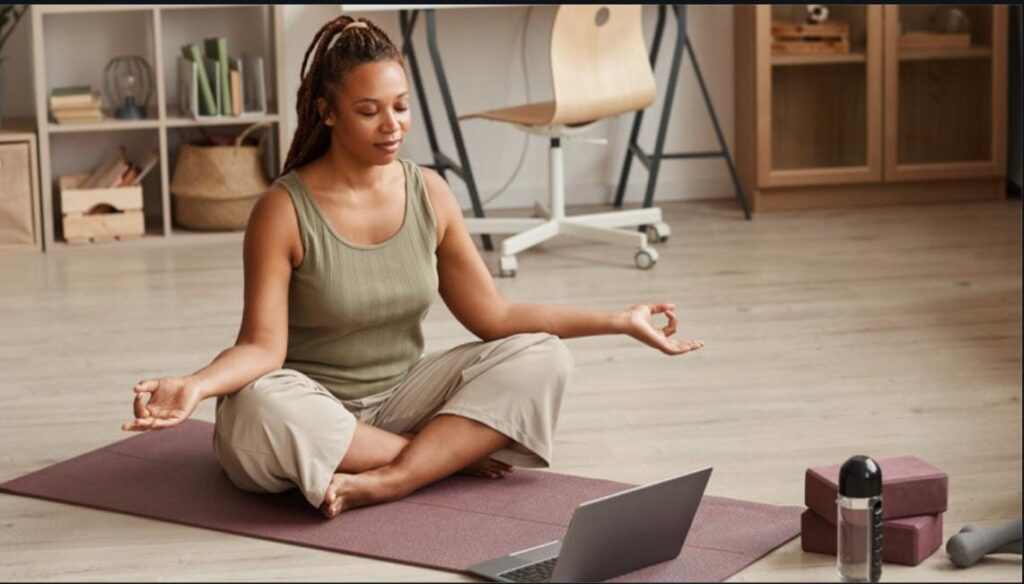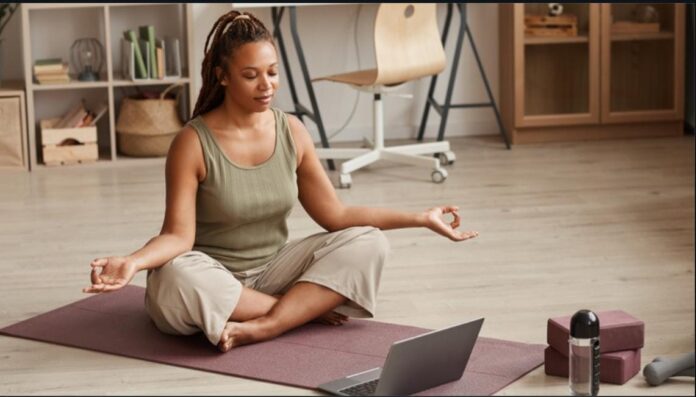Table of Contents
How to Start a Yoga Practice at Home
Yoga is an approach to life that benefits the body, mind, and soul in addition to being a physical workout. It might be difficult to find time in the busyness of everyday life to attend studio yoga classes. On the other hand, beginning a yoga practice at home might afford you the convenience and flexibility you need to put your health first. We’ll go over all you need to know to get started with yoga at home in this extensive tutorial.
Introduction to Starting a Yoga Practice at Home
Importance of Yoga
Yoga is known for many benefits to health and has been practiced for thousands of years. The benefits of yoga are many, including increasing strength and flexibility reducing stress, and boosting mental focus. Including yoga in your regular practice can improve your mental and physical health.
Benefits of Practicing at Home
The benefits of doing yoga at home are many. It is up to you to choose when to practice, modify the routine to fit your needs, and set up an environment to promote concentration and relaxation. In addition, practicing at home saves you money and time over time by removing the need for a trip to a class.
Setting Up Your Space
Choosing the Right Location
Choose a peaceful, clean place for your home yoga practice so that you can practice continuously. Make sure the area—whether it’s an outdoor space, an empty space, or a corner of your living room—promotes peace and allows you to walk around comfortably.
Creating a Calming Atmosphere
Incorporate things that promote peace and calm to enhance the feel of your yoga room. A peaceful setting that promotes mindfulness and relaxation can be created by adding soft lighting, fragrant candles, and calming music.
Gathering Your Equipment
Yoga Mat
For a safe and enjoyable practice, a top-notch yoga mat is needed. To support your positions, choose a mat that offers enough stability and softness. Choose long-lasting, easily-cleanable eco-friendly materials.
Props (Blocks, Straps, Bolsters)
By offering support and helping with position, supports like pillows with bolsters blocks, and belts can improve your yoga practice. Make your practice more approachable and enjoyable by purchasing a few essential accessories to help you along the way.
Finding Suitable Resources
Online Classes and Tutorials
Aspiring yogis can find an endless number of resources on the internet. Discover yoga videos and sessions offered online for all ability levels, from absolute beginners to experts. Online learning environments such as YouTube, Udemy, and YogaGlo offer a wide variety of courses given by qualified teachers.
Yoga Apps
Yoga applications that include guided sessions, customized routines, and progress-tracking capabilities allow you to practice on the move. There is an app for every type of yoga practice, including vinyasa, yin, and hatha.
Books and DVDs
Become more knowledgeable about yoga by exploring books and DVDs written by well-known yoga instructors and followers. You can improve your practice and expand your understanding of yoga philosophy, anatomy, and technique by using these sites, which offer insightful information.

Starting with Basic Poses
Mountain Pose (Tadasana)
Start your practice with the mountain position, a basic stance that improves awareness, balance, and posture. Taking a tall stance and placing your feet hip-width apart, you should extend from the top of your head to the soles of your feet.
Downward-Facing Dog (Adho Mukha Svanasana)
Make your way to downward-facing dog, a soothing pose that develops and extends the entire body. Beginning on your hands and knees, raise your hips toward the ceiling such that your body forms an inverted V.
Child’s Pose (Balasana)
In a child’s position, which is an easy position that promotes release and relaxation, rest and refresh. Lean forward, extending your arms in front of you, and resting your forehead on the ground while you kneel on the mat with your big toes touching and your legs wide apart.
Establishing a Routine
Setting a Schedule
The secret to starting a home yoga practice is consistency. Make time for your practice every day or every week; approach it like a scheduled meeting with yourself that cannot be changed. Make a plan that works for you, whether it’s an evening wind-down to relax or an early flow to get your day started.
Consistency is Key
Commit to regularly practicing on your mat, even on the days you don’t feel like it. As you practice consistently, you’ll gain momentum and witness the life-changing impacts of discipline and perseverance.
Listening to Your Body
Understanding Your Limits
Yoga is about accepting your body’s limitations and engaging in thoughtful, compassionate practice rather than trying to fit your body into molds. Pay attention to your body’s signals and adjust positions accordingly to avoid strain or damage.
Modifications and Variations
Since everybody is different, yoga can be customized to any degree. Explore adjusting and changing stances to fit your unique requirements and skills. There’s a modification for everyone, be it someone healing from an injury, taking care of an ongoing medical condition, or just looking for a more gentle practice.
Exploring Different Styles
Hatha, Vinyasa, Yin, etc.
There are many different forms of yoga, each with a distinct focus and methodology. Try out various styles, including hatha, vinyasa, yin, and restorative, to see what suits you best. You are free to experiment and develop your practice because every style has its own advantages and difficulties.
Finding What Resonates with You
In the end, the most optimal kind of yoga is the one that fulfills your spirit and speaks to your heart. Consider the physical, mental, and emotional effects of each style as you select the practices that fit with your objectives.
Incorporating Meditation and Breathwork
Benefits of Meditation
Your yoga practice will benefit greatly from the addition of meditation, which may help with reducing stress, mental peace, and present-moment mindfulness. By scheduling time for seated meditation, guided visualization, or mindful breathing exercises, you can include meditation into your daily practice.
Pranayama Techniques
A vital part of yoga that improves vigor, clarity, and emotional balance is pranayama, often known as yogic breathing. To strengthen your relationship with your breath and encourage inner harmony, try pranayama exercises like belly breathing, alternating nostril breathing, and deep breathing.
Tracking Your Progress
Keeping a Yoga Journal
Keeping a yoga notebook will help you to record your experiences, insights, and advancements in your yoga practice. Keep a journal of the positions you practice, the difficulties you face, and the victories you have along the road. A useful tool for reflection and self-discovery is your journal.
Celebrating Milestones
Honor your successes and landmarks, no matter how minor they may appear. Celebrate what you’ve achieved in life and on the mat, whether it’s holding a difficult position for an extended period of time or finding silence during meditation.
Overcoming Challenges
Dealing with Distractions
It can be difficult to focus during your yoga practice in a world full with distractions. Reduce the amount of distractions in your life by switching off your phone, closing tabs that aren’t necessary, and setting limits with roommates or relatives. Create a sacred area where you can give your whole attention to the here and now.
Motivating Yourself
When you’re feeling unmotivated, look within and remind yourself of the reasons you first started doing yoga. Think back on the advantages you’ve encountered, the advancements you’ve achieved, and the satisfaction you derive from hitting your mat.
Staying Connected
Joining Online Communities
Joining online yoga communities and forums can help you find support and fellowship as you can meet people who share your interests, exchange stories, and exchange tips. Joining a group of like-minded individuals can help you along the way by offering support, accountability, and inspiration.
Finding a Virtual Yoga Buddy
Assign responsibilities to each other and share your yoga practice experience with a virtual yoga buddy. Arrange online practice sessions with one another, share resources and advice, and acknowledge one another’s progress together. Having a partner who is encouraging can add to the enjoyment and satisfaction of your yoga practice.
Seeking Professional Guidance
Consider Virtual Sessions with a Yoga Instructor
Yoga at home gives you freedom and flexibility, but getting help from a professional teacher can help you take your practice to the next level. Explore online classes with knowledgeable teachers who can provide you with specific criticism, suggestions for alignment, and specially designed sequences to help you improve.
Getting Personalized Feedback
By participating in online workshops, virtual classes, or private sessions, you can get personalized guidance and critique from a yoga instructor. Whether you’re working through particular challenges, improving your posture, or developing your practice, an experienced instructor can offer invaluable support and motivation along the way.
Adapting to Changes
Flexibility in Your Practice
Because life is improbable, your yoga practice should be adaptable too. Be willing to modify your practice to fit in with shifting circumstances, energy levels, and schedules. Accept the ebb and flow of life with grace and resilience, whether it’s a quick practice on a hectic day or a calming session during stressful times.
Embracing Growth
On and off the mat, yoga is an adventure of self-exploration and personal development. Accept the process of development and evolution, realizing that obstacles are a necessary element of the learning process and that progress is not always straight-line. Develop self-acceptance, empathy, and patience as you move through the highs and lows of your yoga practice.
Conclusion
Taking up yoga at home may be a life-changing experience with many benefits for the mind, body, and soul. You can set off on a journey of self-discovery, healing, and power by designating a specific area, assembling the necessary supplies, and investigating materials and styles that speak to you. Always pay attention to your body, maintain consistency, and acknowledge your accomplishments as you go. The practice of yoga is incredibly gratifying and enriching, regardless of experience level.
FAQs (Frequently Asked Questions)
Q: Can I start a home yoga practice if I’m a beginner?
A: Absolutely! Starting a home yoga practice is accessible to practitioners of all levels, including beginners. There are plenty of resources available online to guide you through the basics and help you build a strong foundation.
Q: Is flexibility required for doing yoga?
A: Not at all! It’s not required to be flexible to practice yoga. Yoga is about meeting yourself where you are and honoring your body’s unique abilities. With regular practice, you’ll gradually improve flexibility, strength, and overall well-being.
Q: How long should my home yoga sessions be?
A: The duration of your home yoga sessions depends on your schedule, preferences, and energy levels. Whether it’s a short 15-minute flow or a longer 60-minute practice, consistency is more important than duration.
Q: What should I wear for my home yoga practice?
A: Choose comfortable, breathable clothing that allows for ease of movement and flexibility. During your practice, choose clothing that will go away moisture to keep you dry and cool.
Q: How do I stay motivated to maintain a regular home yoga practice?
A: Find what inspires you and cultivate a sense of discipline and dedication. Set achievable goals, vary your routine to keep things interesting, and seek support from online communities or a virtual yoga buddy to stay accountable and motivated.

